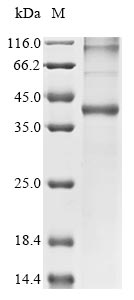Recombinant Culex quinquefasciatus Odorant receptor (6031407) is produced through an in vitro E.coli expression system, covering the complete expression region of 1-393 amino acids. The protein carries an N-terminal 10xHis tag, which helps with purification and detection processes. Purity levels exceed 85% as determined by SDS-PAGE analysis. This product is designed strictly for research purposes and appears to deliver consistent performance in experimental settings.
The Odorant receptor from Culex quinquefasciatus likely plays a central role in how this mosquito species processes smell. It helps detect volatile compounds in the surrounding environment. This protein seems integral to signaling pathways that allow mosquitoes to respond to chemical cues, which makes it an interesting target for studying mosquito behavior and developing vector control strategies. Research on this receptor may contribute to our understanding of how smell works in insects and could lead to new pest management approaches.
Potential Applications
Note: The applications listed below are based on what we know about this protein's biological functions, published research, and experience from experts in the field. However, we haven't fully tested all of these applications ourselves yet. We'd recommend running some preliminary tests first to make sure they work for your specific research goals.
1. Protein-Protein Interaction Studies
This recombinant odorant receptor works well in pull-down assays to identify potential binding partners or co-receptors that might interact with mosquito smell-detection pathways. The N-terminal 10xHis tag allows for immobilization on nickel-affinity matrices, making it easier to capture interacting proteins from mosquito tissue lysates or other expression systems. These studies could reveal previously unknown components of mosquito smell machinery. They may also help researchers understand the molecular basis of odor detection in disease-carrying mosquitoes.
2. Antibody Development and Validation
The purified recombinant protein can serve as an immunogen for creating specific antibodies against Culex quinquefasciatus odorant receptors. Its high purity (>85%) and full-length structure make it appropriate for immunization protocols in laboratory animals. Scientists can then validate these antibodies using the same recombinant protein in Western blot, ELISA, or immunofluorescence applications. This process helps confirm specificity and determine cross-reactivity patterns.
3. Biochemical Characterization and Structural Studies
This full-length recombinant odorant receptor is suitable for basic biochemical analysis. Researchers can determine molecular weight, isoelectric point, and stability under different buffer conditions. The protein may work as starting material for limited proteolysis experiments to identify stable domains. It might also prove useful for biophysical studies such as circular dichroism spectroscopy to assess secondary structure content. The His-tag makes purification straightforward for these analytical applications.
4. Comparative Olfactory Receptor Research
The recombinant protein can be applied in comparative studies examining odorant receptor diversity and evolution across different mosquito species or other dipteran insects. Cross-reactivity studies with antibodies or binding assays using this Culex quinquefasciatus receptor alongside similar proteins from related species could provide insights into conserved versus species-specific features of insect smell systems.
5. In Vitro Assay Development
This recombinant odorant receptor works as a reference standard or positive control when developing screening assays for mosquito smell research. Consistent production from the E. coli expression system and defined purity make it suitable for establishing reproducible experimental protocols. Researchers can use this protein to optimize buffer conditions, validate detection methods, or standardize experimental procedures across different laboratories studying mosquito chemoreception.






